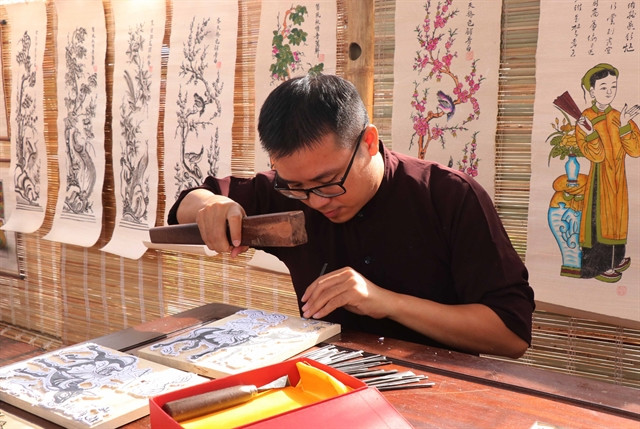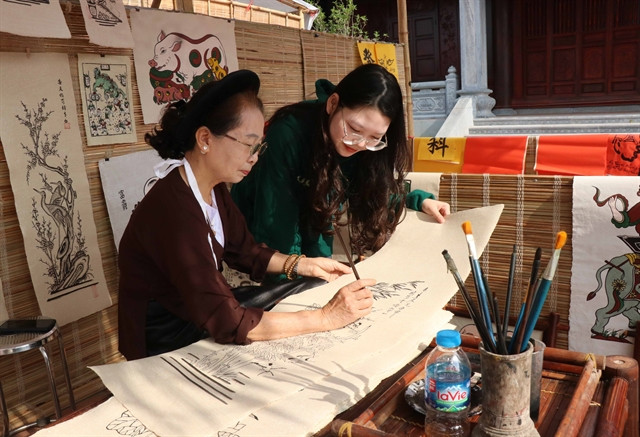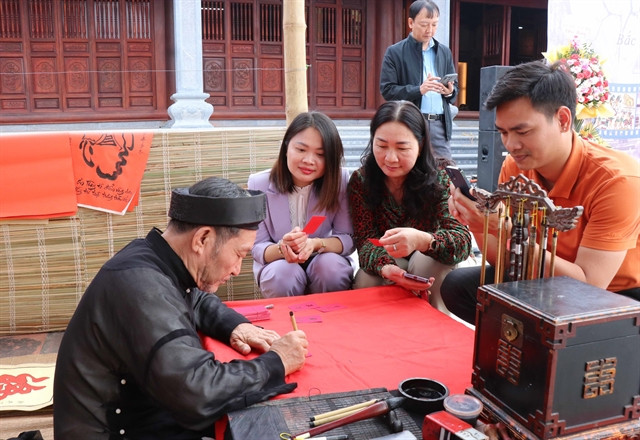 |
| An artist engraves a design on a wood block which is later to be used as a stamp to press on the paper to make a print. VNA/VNS Photo Thanh Thương |
Đông Hồ Painting Market flourished for centuries in the northern province of Bắc Ninh until it was halted in the mid-1940s due to war. Although the market was no longer held, the memories of its glorious past remain etched in the minds of old folk.
Aiming to revive such a distinctive cultural activity, the Department of Culture, Sports, and Tourism of Bắc Ninh has restored the folk painting market at Song Hồ Ward's Centre for the Preservation of Folk Paintings.
Đông Hồ paintings (actually woodblock prints) belong to a traditional genre of Vietnamese block printing originating from Đông Hồ Village, now part of Tú Khê Quarter, Song Hồ Ward, Thuận Thành Town.
These prints were mostly purchased to decorate houses during Tết (Lunar New Year) holiday so they were also referred to as Tết paintings. Over time, they were not only displayed during Tết, but also throughout the year.
Artisan Nguyễn Đăng Chế, one of the few individuals still practising this ancient craft in Song Hồ, said that the Đông Hồ painting market traditionally was held at the Đông Hồ communal house on several days approaching Lunar New Year festival.
 |
| Visitors learn about the process of making Đông Hồ folk paintings at the market. VNA/VNS Photo Thanh Thương |
“Each market day, thousands of paintings were displayed for sale. What made it unique was that people could either buy the prints with money or exchange their goods for them,” he said.
“Customers came from various provinces near and far by boats along the Đuống River or by land roads. Traders brought their local speciality products with them, such as fish sauce from the central provinces of Thanh Hóa and Nghệ An, silk cloth from Hà Nam, black tobacco from Hải Phòng, or tea from Phú Thọ, to barter for the prints.
"The Đông Hồ villagers were renowned for their artistic skills and open-mindedness, which made the buying and selling easy and enjoyable."
During wartime and especially after 1945, the market came to a halt, but its vibrant atmosphere remains in the memories of old folk, like 88-year-old Nguyễn Thị Yểng in Song Hồ Ward.
“During those days, the entire area surrounding the village communal house was vibrantly colourful with paintings spread out on mats, hung on walls and strings. The atmosphere of the market on the days before Tết was bustling and joyful, similar to a festival,” she said.
Immersed in the festive atmosphere while attending the re-enacted market last month, Yểng said she felt like she was returning to the old days when the Đông Hồ block printing was in its heyday.
“It was like a small corner of the old painting market coming back to life,” she said.
Revival
The re-enacted Đông Hồ Painting Market includes 20 booths that not only showcase folk paintings for sale, but also enable visitors to learn about the process of woodblock printing.
Each booth is dedicated to a different theme, like materials for printing, an exhibition of ancient paintings, the printing process in which visitors can get involved, or a display of local speciality products.
Nguyễn Thị Oanh, the only female artisan of the Đông Hồ block printing, said she had prepared artworks of various themes, from traditional to modern.
“I have created over 50 different themes for printings, and have been honoured to have my artworks exhibited abroad, and now I have another chance to introduce them to the public at this market," she said.
“I hope to contribute to the preservation of the traditional craft of my homeland, and that the market will be organised more frequently.”
Hà Quý Minh Tuấn, a student at the Song Hồ Secondary School, said he only knew about the renowned traditional art form of his hometown through literary works.
"This is the first time I have had the opportunity to witness the process of creating these prints, as practised by our ancestors," he said.
The block printing process includes engraving a design on a wood block, inking the design, and then using the block as a stamp to press on the paper to make a print.
The dyes used in the prints are unique and natural, such as red clay, black charcoal, green bamboo leaves, and yellow flowers.
The paintings mostly depict such familiar animals as roosters, hens and chicks, pigs, and carp. They also feature flowers and women, and common activities in rural life.
 |
| Visitors buy calligraphic works at Đông Hồ Painting Market. VNA/VNS Photo Thanh Thương |
In addition to the annual Đông Hồ Painting Market, the province's culture authority has established the Đông Hồ Folk Painting Conservation Centre, which displays over 1,000 documents and artefacts related to the art form.
They are parts of the province's efforts to revive and promote the traditional woodblock printing, which was announced as a national intangible cultural heritage in 2013.
 |
| Representatives of Bắc Ninh authorities attend the re-opening of Đông Hồ folk painting market. VNA/VNS Photo Thanh Thương |
In March 2020, Việt Nam submitted the dossier on Đông Hồ folk paintings to UNESCO for inclusion in the list of intangible cultural heritages in need of urgent safeguarding.
It is expected to be reviewed at the 19th session of the Intergovernmental Committee for the Safeguarding of Intangible Cultural Heritage in 2024. VNS